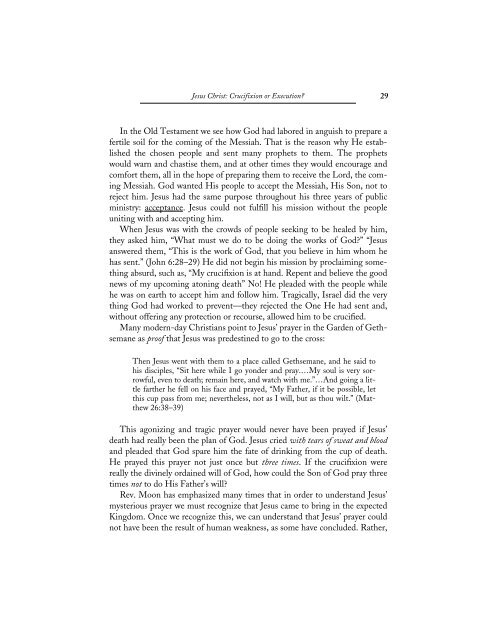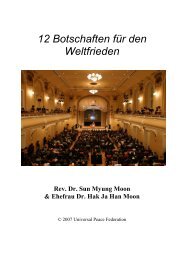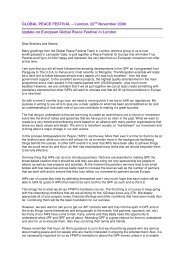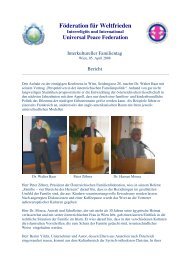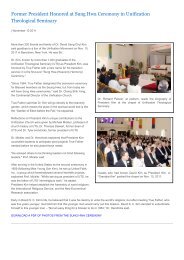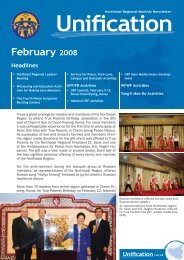New Truth In The Last Days - True Parents Organization
New Truth In The Last Days - True Parents Organization
New Truth In The Last Days - True Parents Organization
You also want an ePaper? Increase the reach of your titles
YUMPU automatically turns print PDFs into web optimized ePapers that Google loves.
Jesus Christ: Crucifixion or Execution? 29<br />
<strong>In</strong> the Old Testament we see how God had labored in anguish to prepare a<br />
fertile soil for the coming of the Messiah. That is the reason why He established<br />
the chosen people and sent many prophets to them. <strong>The</strong> prophets<br />
would warn and chastise them, and at other times they would encourage and<br />
comfort them, all in the hope of preparing them to receive the Lord, the coming<br />
Messiah. God wanted His people to accept the Messiah, His Son, not to<br />
reject him. Jesus had the same purpose throughout his three years of public<br />
ministry: acceptance. Jesus could not fulfill his mission without the people<br />
uniting with and accepting him.<br />
When Jesus was with the crowds of people seeking to be healed by him,<br />
they asked him, “What must we do to be doing the works of God?” “Jesus<br />
answered them, “This is the work of God, that you believe in him whom he<br />
has sent.” (John 6:28–29) He did not begin his mission by proclaiming something<br />
absurd, such as, “My crucifixion is at hand. Repent and believe the good<br />
news of my upcoming atoning death” No! He pleaded with the people while<br />
he was on earth to accept him and follow him. Tragically, Israel did the very<br />
thing God had worked to prevent—they rejected the One He had sent and,<br />
without offering any protection or recourse, allowed him to be crucified.<br />
Many modern-day Christians point to Jesus’ prayer in the Garden of Gethsemane<br />
as proof that Jesus was predestined to go to the cross:<br />
<strong>The</strong>n Jesus went with them to a place called Gethsemane, and he said to<br />
his disciples, “Sit here while I go yonder and pray.…My soul is very sorrowful,<br />
even to death; remain here, and watch with me.”…And going a little<br />
farther he fell on his face and prayed, “My Father, if it be possible, let<br />
this cup pass from me; nevertheless, not as I will, but as thou wilt.” (Matthew<br />
26:38–39)<br />
This agonizing and tragic prayer would never have been prayed if Jesus’<br />
death had really been the plan of God. Jesus cried with tears of sweat and blood<br />
and pleaded that God spare him the fate of drinking from the cup of death.<br />
He prayed this prayer not just once but three times. If the crucifixion were<br />
really the divinely ordained will of God, how could the Son of God pray three<br />
times not to do His Father’s will?<br />
Rev. Moon has emphasized many times that in order to understand Jesus’<br />
mysterious prayer we must recognize that Jesus came to bring in the expected<br />
Kingdom. Once we recognize this, we can understand that Jesus’ prayer could<br />
not have been the result of human weakness, as some have concluded. Rather,


